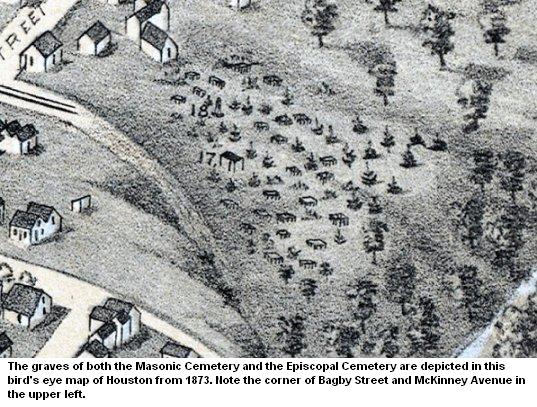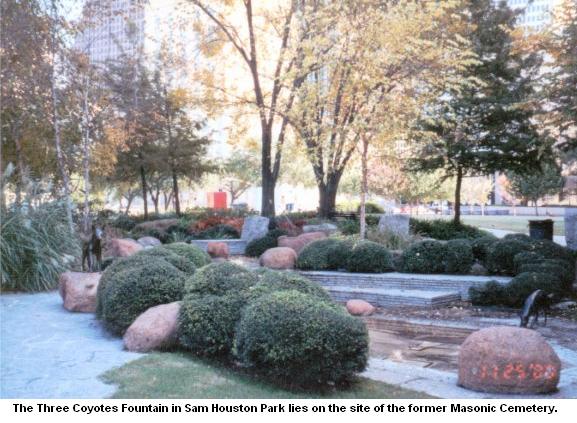About 1847, the Masonic Cemetery was established by Holland Lodge No. 1 on 3/4 acres (34,583 sq ft) on the banks of Buffalo Bayou in the far southwest part of town off Bagby Street at Lamar Avenue. George H. Bringhurst was a Mason who served as the secretary and the treasurer of Holland Lodge No. 1 for more than thirty years. Bringhurst was the City surveyor for ten years during the 1840's and he owned property on Bagby Street. Quite possibly, through his efforts that the land for the Masonic Cemetery was acquired. Since the Masonic Cemetery and the adjacent Episcopal Cemetery have traditionally been linked, the Episcopal Cemetery may have been established at this time as well. Together, the two cemeteries consisted of about two acres of land in a long and narrow strip extending from a one lot "set back" from Bagby Street to the bayou.
Those buried at Episcopal Cemetery included Stephen Richardson, one of Stephen F. Austin's Old 300 settlers. The 28 year old Richardson was shipwrecked near the mouth of the Brazos on December 22, 1822. He went on to San Felipe de Austin and established a business with Thomas Davis. In January, 1838, Richardson moved to Harrisburg where he operated a steam sawmill until about 1848. He moved to Houston in early 1849 and he died in Houston on July 6, 1860 at age 66.
 Moseley Baker, a veteran of San Jacinto and a legislator
in the Republic, died on November 4, 1848 of yellow fever in Houston.
He was buried initially in the City Cemetery on Elder Street, but was
later moved to the Episcopal Cemetery. The remains of Baker and
his wife were moved to the State Cemetery in Austin in 1929.
Moseley Baker, a veteran of San Jacinto and a legislator
in the Republic, died on November 4, 1848 of yellow fever in Houston.
He was buried initially in the City Cemetery on Elder Street, but was
later moved to the Episcopal Cemetery. The remains of Baker and
his wife were moved to the State Cemetery in Austin in 1929.Also buried at the Episcopal Cemetery are the children of Mrs. Priscilla Hadley Key, a descendant of Francis Scott Key who wrote the Star Spangled Banner, our national anthem.
The most notable burial in the Masonic Cemetery was that of Anson Jones, the last president of the Republic of Texas, who died on January 9, 1858. Jones' remains were subsequently moved to Glenwood Cemetery.
The City Council prohibited interments in the Episcopal Cemetery and the Masonic Cemetery in 1879. At that time some of the bodies in the Episcopal Cemetery and the Masonic Cemetery were unearthed and reinterred in Glenwood Cemetery. There is some indication that, in spite of the ban, the last burial in the Masonic Cemetery was in 1900. Without a doubt, though, both cemeteries were neglected and fell into disarray. Many of the headstones lay broken and scattered. The two acre tract surrounded by a five foot metal fence was unkempt and overgrown with weeds. With the construction of the new City Hall on Bagby Street and the civic center development on the west side of downtown, more graves were removed from the Episcopal Cemetery and reinterred in Brookside Cemetery in 1938.
 In 1959, the expansion of the Civic Center with the
construction of the City Hall Annex on the west side of Bagby Street
and the expansion of Sam Houston Park required the removal of the two
cemeteries. An additional eighty bodies were moved from the site to
Glenwood Cemetery.
In 1959, the expansion of the Civic Center with the
construction of the City Hall Annex on the west side of Bagby Street
and the expansion of Sam Houston Park required the removal of the two
cemeteries. An additional eighty bodies were moved from the site to
Glenwood Cemetery.Today, there is no visible sign of the two old cemeteries. The exit ramp from I-45 to McKinney Avenue covers part of cemetery tract while the exhibits of Sam Houston Park have replaced the remainder. The Three Coyotes Fountain, a 1992 work by California sculptor Gwynn Murrill, lies over much of the former Masonic Cemetery. The bronze scavengers seem to be appropriate protectors of the ghosts of early Houston.